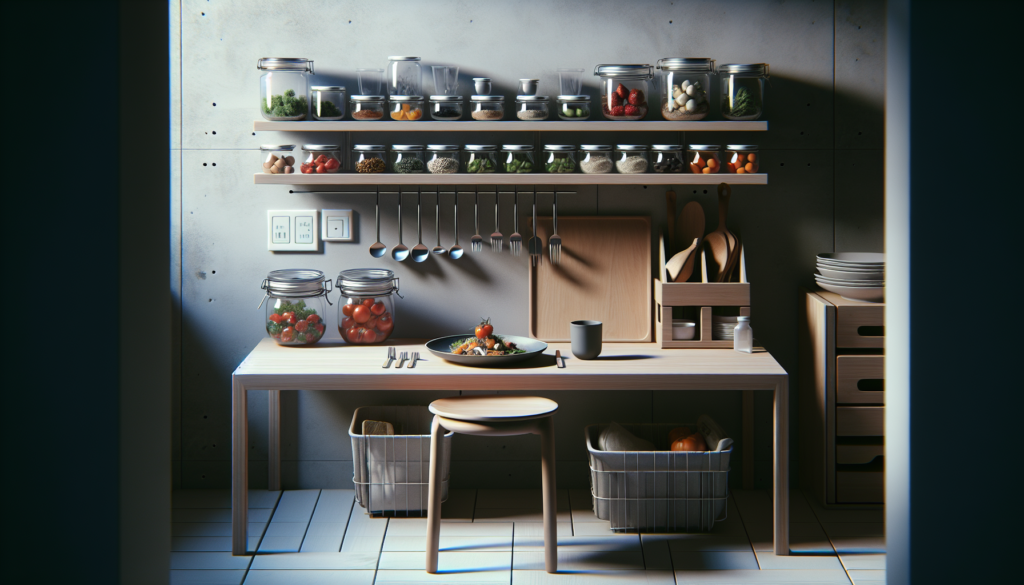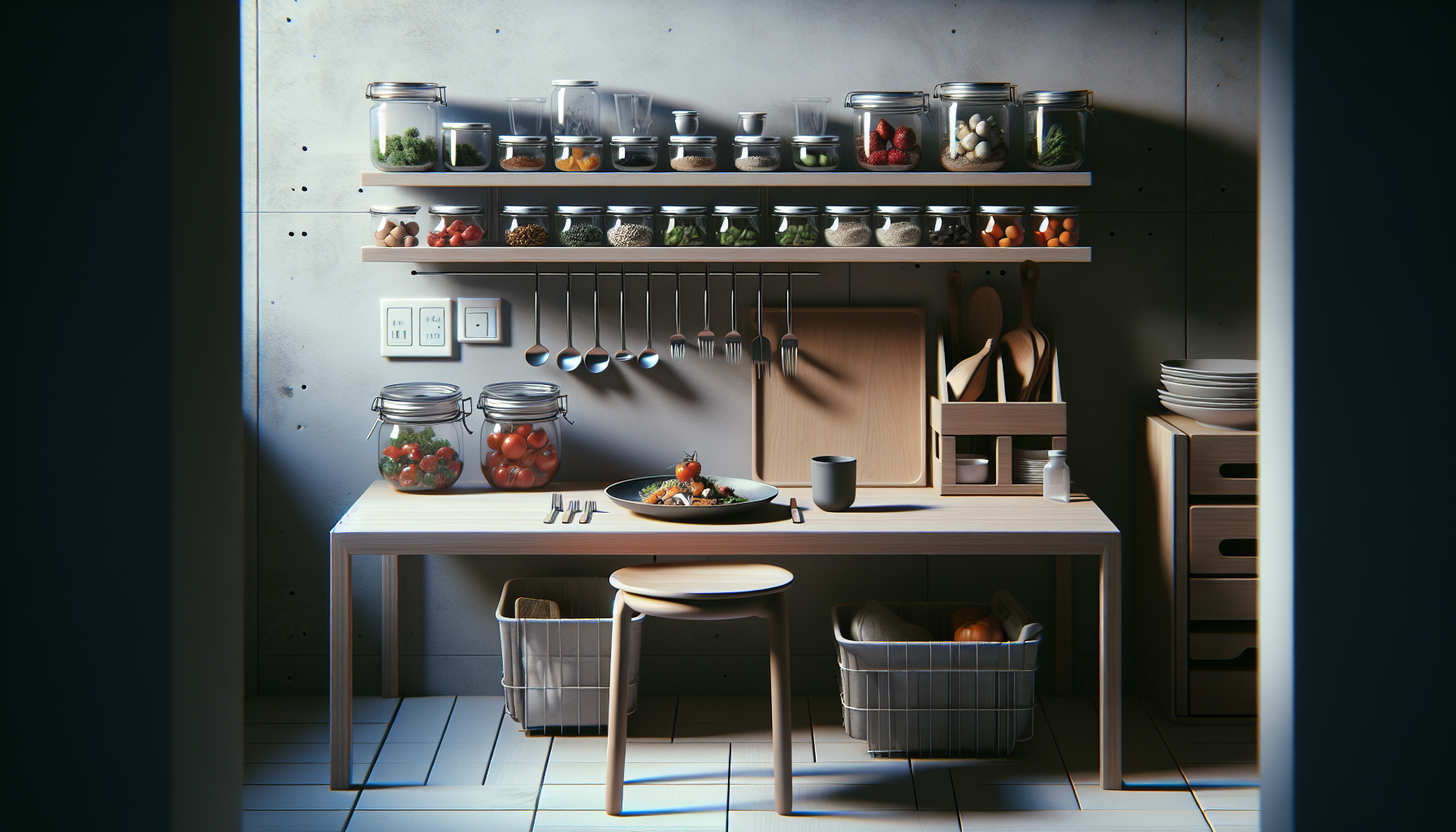Are you tired of cooking big meals only to end up with leftovers that go to waste? In “How Can I Cook Solo Meals Without Creating Food Waste?” we explore practical tips and strategies to help you cook delicious solo meals without creating unnecessary food waste. Whether you’re a busy professional or simply prefer cooking for one, this article will provide you with useful insights to minimize food waste while still enjoying tasty and satisfying meals. From meal planning to clever storage solutions, we’ve got you covered in your quest to cook solo without creating food waste.

Planning ahead
Making a meal plan
Planning ahead is key to creating delicious and waste-free meals. By taking the time to map out your meals for the week, you can ensure that you are using up ingredients efficiently and avoiding unnecessary waste. Sit down with a pen and paper or use a meal planning app to jot down your meal ideas. Consider what ingredients you already have on hand and plan meals that will utilize those items. This will not only save you money but also prevent food from going to waste.
Creating a shopping list
Once you have your meal plan in place, it’s time to create a shopping list. Take a look at each recipe and make note of the ingredients you’ll need. Be specific and list quantities to avoid buying more than necessary. By having a detailed shopping list, you can avoid impulse purchases and only buy what you need. This will help minimize waste and also save you from wasting money on ingredients that may go unused.
Storing ingredients properly
Understanding expiration dates
Understanding expiration dates is crucial in preventing food waste. Many people mistakenly throw away perfectly good food because they misinterpret expiration dates. It’s important to differentiate between “sell-by,” “use-by,” and “best-by” dates. The “sell-by” date is for the store’s reference and doesn’t necessarily mean the food will spoil immediately after. “Use-by” dates indicate when the food is at its peak quality but doesn’t mean it’s unsafe to consume afterward. “Best-by” dates refer to the date when the food is expected to still taste best, but it can still be safe to eat beyond that. By understanding these dates, you can avoid unnecessary waste and make the most of your ingredients.
Using storage containers
Properly storing ingredients is essential for extending their shelf life and reducing food waste. Invest in airtight storage containers to keep your ingredients fresh for longer. These containers will help prevent spoilage and keep your food tasting its best. When storing fruits and vegetables, it’s important to store them separately to prevent cross-contamination and premature spoiling. Additionally, consider using clear containers to easily see what’s inside and avoid forgetting about items tucked away in the back of the fridge.
Utilizing leftovers
Reinventing leftovers
Leftovers don’t have to be boring! Get creative and reinvent your leftovers into new and exciting dishes. For example, leftover roasted chicken can be used to make a delicious chicken salad or added to a pasta dish. Leftover vegetables can be repurposed into a flavorful soup or used as toppings for homemade pizzas. By thinking outside the box and experimenting with flavors, you can transform your leftovers into satisfying meals, minimizing waste in the process.
Freezing meals
When you find yourself with excess food that may not be consumed immediately, freezing meals is a great option. Invest in freezer-safe containers or use zip-top freezer bags to store meals for later use. Portion out your leftovers into single-serving sizes to ensure easy defrosting and prevent waste. Freezing meals gives you the flexibility to enjoy your leftovers at a later date instead of letting them go bad in the fridge. Not only does freezing meals help reduce waste, but it also saves you time and money by having pre-made meals on hand.
Choosing appropriate portion sizes
Cooking single-serving recipes
When cooking solo, it’s important to consider appropriate portion sizes to avoid overcooking and generating unnecessary waste. Look for recipes specifically designed for one or utilize tools that allow you to adjust the serving size of a recipe. Cooking single-serving recipes not only ensure you’re making just the right amount of food, but it also allows you to experiment with a variety of dishes without worrying about leftovers going to waste.
Using kitchen scales
Kitchen scales are a handy tool when it comes to portion control and reducing food waste. By weighing your ingredients, you can accurately measure quantities, preventing excessive cooking and potential waste. Additionally, using a kitchen scale allows you to portion out ingredients precisely, especially when it comes to bulk items like rice, pasta, or grains. This helps you cook only what you need, saving both money and resources.

Using versatile ingredients
Opting for pantry staples
Stocking your pantry with versatile ingredients is a smart way to minimize waste and ensure you always have the necessary basics on hand. Pantry staples like rice, beans, pasta, canned tomatoes, and spices can be used in a wide variety of recipes. They have a long shelf life and can be the base for many meals. By having these versatile ingredients stocked in your pantry, you’ll be better equipped to create meals without needing to run to the store and risking purchasing unnecessary items that may go unused.
Choosing multipurpose ingredients
Choosing ingredients that can be used in multiple dishes is another way to minimize waste. For example, fresh herbs like basil, parsley, or cilantro can be used in various recipes or as garnishes. Using versatile ingredients like eggs, which can be used in both sweet and savory dishes, allows you to make the most out of a single item. By strategically selecting multipurpose ingredients, you are not only reducing waste but also maximizing the potential of each item in your kitchen.
Minimizing food waste
Properly measuring ingredients
Properly measuring ingredients is crucial in minimizing food waste. When a recipe calls for specific quantities, it’s important to follow those measurements accurately. Overestimating or underestimating ingredient amounts can lead to excess food or a lack of flavor. Utilize measuring cups, spoons, and kitchen scales to ensure you’re adding just the right amount. By measuring ingredients properly, you’ll create balanced dishes and minimize unnecessary waste.
Using up small quantities of ingredients
Oftentimes, recipes may only call for small quantities of specific ingredients, leaving you with leftover portions that may go to waste. Instead of letting them sit in the fridge or pantry indefinitely, find creative ways to use them up. For example, leftover herbs can be blended into pesto or mixed into scrambled eggs. Overripe fruits can be transformed into smoothies or used in baking. By utilizing these small quantities of ingredients, you’ll not only prevent waste but also add new flavors and variety to your meals.
Cooking methods to avoid food waste
Stir-frying
Stir-frying is a cooking method that is perfect for using up leftover vegetables and proteins. By quickly cooking these ingredients in a hot pan with a small amount of oil, you can create a flavorful and nutritious meal in no time. The high heat of stir-frying helps retain the vibrant colors and textures of the vegetables, resulting in a visually appealing dish. Be creative with your stir-fries, experimenting with different sauces, spices, and proteins to create unique and delicious meals while minimizing waste.
Roasting vegetables
Roasting vegetables is another cooking method that helps reduce food waste. By roasting vegetables that are slightly past their prime, you can bring out their natural flavors and transform them into delicious side dishes or main components of a meal. The heat of the oven caramelizes the sugars present in the vegetables, resulting in a sweet and savory flavor profile. Additionally, roasted vegetables can be stored in the fridge and used as toppings for salads, fillers for sandwiches, or added to soups and stews.
Buying in bulk
Buying from bulk bins
When possible, try buying ingredients from bulk bins. Bulk bins allow you to purchase exactly the amount you need, reducing the risk of ingredients going to waste. Whether it’s rice, nuts, spices, or grains, buying from bulk bins allows you to be more mindful of how much you actually require. This not only helps minimize food waste but also saves money as you only pay for the quantity you need.
Using bulk food stores
Many grocery stores offer bulk food sections. These stores specialize in selling products in bulk quantities, allowing you to buy larger quantities of ingredients at a lower cost. By purchasing in larger quantities and storing them properly, you can reduce packaging waste and have pantry staples readily available. Just ensure you have enough storage space and the ingredients won’t go bad before you can use them.
Composting
Starting a compost bin
Composting is an excellent way to reduce food waste while also benefiting the environment. By starting a compost bin at home, you can turn food scraps, such as fruit and vegetable peels, coffee grounds, and eggshells, into nutrient-rich compost that can be used to fertilize plants and gardens. Composting not only diverts waste from landfills but also helps reduce greenhouse gas emissions. It’s a simple and effective way to give back to the earth while minimizing your ecological footprint.
Choosing compostable materials
When purchasing products, consider opting for compostable materials. Many items, such as coffee filters, tea bags, and paper towels, are made from materials that can be composted. By choosing these products, you are supporting the composting process and contributing to a more sustainable future. Additionally, using compostable materials reduces the amount of waste that ends up in landfills, helping to preserve the environment for future generations.
Reducing packaging waste
Buying from local markets
Shopping at local markets is not only a great way to support local farmers and businesses but also a way to reduce packaging waste. Local markets often offer fresh produce that is not overly packaged, allowing you to bring your own reusable bags and containers. By purchasing fruits, vegetables, and other food items without excessive packaging, you minimize the waste that goes into landfills. Plus, you get the added benefit of enjoying fresh, locally sourced ingredients that are in season.
Bringing reusable containers
When shopping for groceries or takeout meals, bring your own reusable containers. By doing so, you can avoid contributing to the growing issue of single-use plastic and packaging waste. Many stores and restaurants are happy to accommodate customers who bring their own containers, helping to reduce the environmental impact of packaging waste. So remember to carry a set of reusable containers in your bag whenever you’re out and about, allowing you to enjoy your meals waste-free and guilt-free.
In conclusion, cooking solo meals without creating food waste requires some planning and conscious effort. By making a meal plan, using storage containers, and utilizing leftovers, you can ensure that you’re making the most out of your ingredients. Choosing appropriate portion sizes, using versatile ingredients, and minimizing food waste through proper measuring and creative use of small quantities can further help in reducing waste. Cooking methods like stir-frying and roasting vegetables not only add flavor but also reduce food waste. Buying in bulk, composting, and reducing packaging waste are additional strategies that can make a significant difference. So, be mindful of your cooking practices, implement these tips, and enjoy waste-free, delicious meals every time you step into the kitchen.
